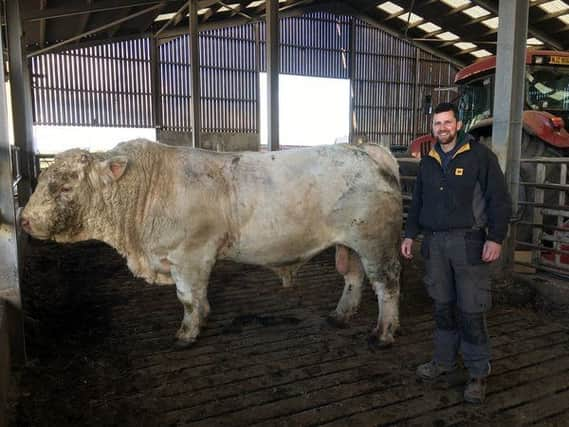Watson's success with Charolais sustainablebeef sire


“Achieving an average of 380kg deadweight is not new for us,” says Fergal Watson. “Our objective has always been to maximise the number of kilos produced per cow and to realise that weight gain as early as possible. The quicker these stock finish, the quicker they’re off the farm.
“Our farm is an extensive unit providing for two families, the complementary 300 acres arable and 450 acres livestock enterprises are run as separate, efficient businesses and as far as the 250 herd is concerned, then each suckler cow has to justify her existence. Everything has to work and make money. We produce high quality finished cattle all sold deadweight.
Advertisement
Hide AdAdvertisement
Hide Ad“We have in the herd the genetics to achieve that fast weight gain, and Charolais is the breed to do the job, we have tried and tested other terminal sires but nothing achieves the output of the Charolais. We are aware that it’s the nutrition and management that really makes the difference. In fact, fast weight gain is essential whatever the system and it can be adjusted to suit the new grid.”
Fergal Watson’s system: key features
Genetics
Charolais has been the preferred terminal sire for 25 years. Bulls are selected initially on visual appraisal for feet and mobility, and then from the EBV’s, in particular for weight and calving ease.
Simmental cross cows are the preferred females and bred on the farm. Heifer replacements are selected for size, feet, temperament and maternal qualities.
Management
A 12 week calving period is maintained in the spring calving herd, and six weeks in autumn, to help simplify management. It is intended that autumn calving herd will be phased out over the next two years and the spring calving herd increased.
Advertisement
Hide AdAdvertisement
Hide AdBulls and heifers are separated at four months enabling a tailored nutrition programme which takes in to account their very different requirements.
Heifers are allowed to grow to achieve adequate frame size before and start creep feeding about four to six weeks before weaning, and are continued through to be intensively finished. The young bulls are started on creep feeding when separated at four months and pushed intensively to finishing.
Nutrition
Diets are all home mixed using the same basic ingredients – homegrown forage and cereals combined with cost effective bought in straights and balancers, with some acid buff for the bull’s feed. The key is formulating diets specific to age, weight and gender, consequently they offer flexibility to vary starch and protein levels at key stages of development. See Table 3.
Measuring and monitoring
Sample batches are weighed and benchmarked – at birth, at eight month weaning and thereafter at six weekly intervals until reaching target finishing weight.
Advertisement
Hide AdAdvertisement
Hide Ad“We rate weighing a great management tool and time well spent,” says Fergal, “Whilst good stockmen have a fair idea of how the beasts are performing, sometimes you get a surprise.”
Health
The Watsons run a closed herd and only buy in herd sires which are generally selected from pedigree breeders with high herd health status. The farm herd health plan is reviewed annually with the farm vet and at present the Watson’s vaccinate against black leg and pneumonia.
Continental sires, and in particular Charolais noted for its weight for age, have an important role to play in efficient beef production; they are able to finish to heavier weights in a shorter period of time and thereby demonstrate improved efficiency. Consequently, now is the time to be increasing output if farmers wish to maintain a profitable and sustainable system.
Data from Northern Ireland cattle slaughtered in 2015 highlights the crux of the current issue – that Continental sires are associated with improved output, from young bulls, steers and heifers. See table 1. Finishers’ immediate challenge is to manage these Continental cross progeny to fit market specifications.
Advertisement
Hide AdAdvertisement
Hide AdTo successfully meet the challenge, finishers should consider the following blueprint strategy focused on:
1, Management: rethink your current strategy to achieve the new specification – plan from birth
2, Nutrition: split young bull/steers and heifers from the creep stage and feed specific gender formulated diets through to finishing. Work closely with your nutritionist.
3, Measure and monitor: weigh the animals at regular intervals; benchmark both within and outwith the herd.
4, Health: introduce a herd health management plan.
Advertisement
Hide AdAdvertisement
Hide Ad5, Assess individual animal health by monitoring slaughter house health reports.
Charolais cross steers: reduce the store/growing stage. Higher energy diets introduced earlier will reduce the frame size whilst a balanced diet will provide adequate fat cover at optimal weight. Benchmark target weights per age and stage towards the end goal.
Target: 390kgs deadweight, 705kgs live weight by 610 days; aim for 1.1kgs DLG or better from birth.
Charolais cross heifers: one of the greatest inefficiencies within the UK beef industry is our sub-optimal output from heifers, and any move away from Continental sires threatens to exacerbate this trend. There are real opportunities here for producers to improve heifer output by using Charolais genetics.
Advertisement
Hide AdAdvertisement
Hide AdQuality protein is key through the first year of life starting at 18% CP and keeping that CP level at an average 2% higher than the steers throughout the finisher period; do not introduce the same high energy and starch levels formulated for feeding to the steers. Your aim is to encourage heifer frame size without laying down excess fat.
Target: 360kgs deadweight 650kgs live weight by 550 days; aim for 1.1kgs DLG or better from birth.
The Northern Ireland Charolais Club is hosting its Autumn Sale on the 4th November at Dungannon Farmers Mart, show 11am sale 1pm 65 Bulls and 15 Females and the Dispersal of the Liscurry Herd.